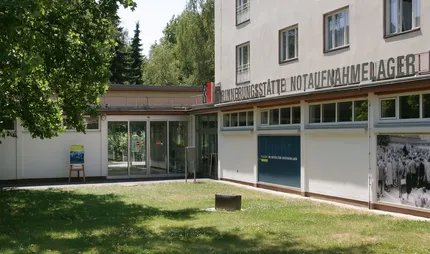
World history right up close
Tempelhof-Schöneberg is a time machine!
Take a journey to the past in Tempelhof-Schöneberg. Find out more about the buildings planned by the Nazis. Tours, installations and the transit camp for refugees from the GDR will tell you even more.
In 1941 the Nazis wanted to know how far a triumphal arch for their planned world capital Germania would settle into the earth – they didn’t want the huge edifice to subside in the Brandenburg sand. So Nazi architect Albert Speer had the 12,650-tonne weight of one pillar cast in reinforced concrete. The huge concrete weight, called the Schwerbelastungskörper, was originally intended to be removed after 20 weeks, but that never happened. It later proved impossible to safely demolish with explosives without endangering the surrounding residential buildings. And so the cylinder still stands today – 70 years later – leaning slightly among the trees and bushes, the only relict of the planned north-south-axis of Germania. In relation to its volume the 21-metre wide Schwerbelastungskörper is the heaviest building in the city and stands as a monument to the megalomania of the Nazis. Berliner Unterwelten e.V. organised tours where you can find out more about the building and its history.
Geschichtsparcours Papestraße
Next to it is the Geschichtsparcours Papestraße, a history trail that takes you through the allotments and the listed barracks buildings, with 30 panels telling the story of the former military premises. Find out more about colonialism, industrialisation, the two world wars and the Cold War.
At the end of the trail you come to the SA-Gefängnis Papestraße, a prison run by the Sturmabteilung and one of the few preserved buildings used by the Nazis for their atrocities. Worn stone steps lead down to a deep, dark, cold cellar with corridors, doors and cells. The rooms were used to keep prisoners and are still largely in their original condition. In one room you can see a film made in 2005 where contemporary witnesses tell schoolchildren from Tempelhof about their life in the cellars. If you look closely, you will see drawings, occasional words and dates written on the walls by the prisoners.
Memorial plaques in Bayrisches Viertel
An installation in the Bayrisches Viertel stands as a reminder of expulsion and deprivation of rights. 80 double-sided signs hang on the lampposts here; on one side are innocent images such as bread, letters or blackboards. On the reverse side, the laws that led to the persecution of German Jews are printed. This memorial is entitled “Places of Remembrance in the Bavarian Quarter – Exclusion and Deprivation, Expulsion, Deportation and Murder of Berlin’s Jews from 1933 to 1945” and extends throughout the entire neighbourhood.
Notaufnahmelager Marienfelde
A large crowd of people stand waiting outside a building with long, rectangular window alcoves. On the left part of the building the word “Notaufnahmelager” is written in large white letters. The right part of the building has several floors, and a woman dressed in white, possibly a nurse, is standing at one of the windows looking down at the people waiting with doubtful expressions in front of the building. In the foreground a woman leans over a pram, and behind her a suitcase peeps out from the waiting crowd.
This picture is a photograph taken on 14 August 1961. It has been blown up to several metres in size and hangs on the façade of the former Marienfelde transit camp for refugees from the GDR. One day after the East German authorities started casting the border between West and East Berlin in concrete, there were still a few gaps in the wall where it was possible to get through. So thousands of people frantically took their last chance to escape to the west. The Marienfelde transit camp had already been the main point of call for refugees and migrants from the GDR for eight years. By the time of reunification, a total of 1.35 million people had passed through the camp on their flight to the West.
Find out more about the city’s neighbourhoods with our Going Local Berlin app.



